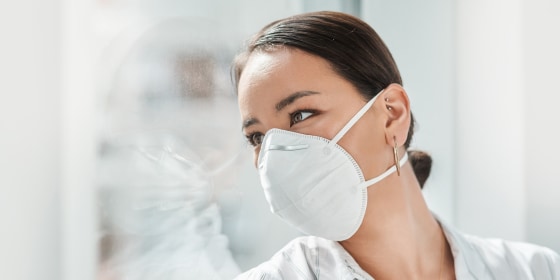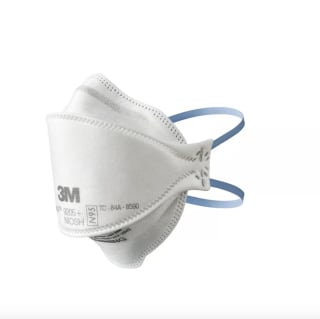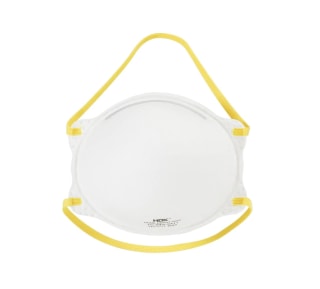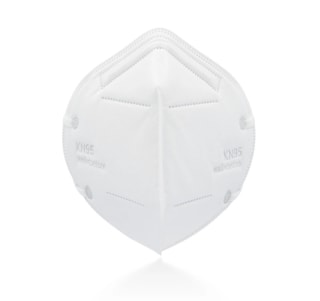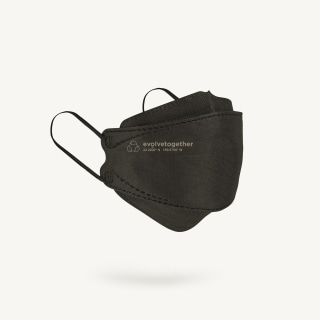With illnesses like COVID, flu and respiratory syncytial virus spiking across the U.S., you may be considering putting on a mask before you step outside.
Wearing a mask amid a spike in respiratory viruses is “kind of a common sense thing,” Dr. Joseph Khabbaza, a pulmonary and critical care specialist at the Cleveland Clinic, previously told TODAY.com
But not all masks are created equal. According to the Centers for Disease Control and Prevention, "well-fitting disposable surgical masks and KN95s" offer even more protection than woven cloth masks, "and well-fitting NIOSH-approved respirators (including N95s) offer the highest level of protection."
“I think the key is to prioritize getting N95-caliber masks the same way you would making sure the seatbelts in your car work or that you have a fire extinguisher at home,” Ranu Dhillon, an epidemic response specialist at Harvard Medical School, said to Shop TODAY.
We compiled the current guidance and spoke to experts about when to wear masks with higher filtration protections, and what to look for when shopping for them.
When to wear a N95 mask | Difference between N95s, KN95s and KF94s | Are masks reusable? | N95 masks | How to shop for KN95 masks | KN95 masks | Masking for wildfire smoke
When to wear a N95 mask
“What the CDC is recommending, really, is a well-fitting mask, or the highest-level of protection that you can get. If you’re caring for somebody with COVID-19 and you have access to a N95 mask or KN95 mask, you should probably be wearing that,” Waleed Javaid, MD, director of Infection Prevention and Control for the Mount Sinai Health System in New York City, and Professor of Infectious Disease at the Icahn School of Medicine at Mount Sinai, told us.
“If you are at risk or you’re immunocompromised and you have a weakened immune system or certain other issues, you might want to wear a KN95 or something similar,” Javaid continued. Those who are traveling, on public transportation for extended periods of time or are in crowded areas should also consider wearing a N95 or KN95 mask, he said.
What’s the difference between N95s, KN95s and KF94s?
N95s, KN95s and KF94s offer different levels of particle filtration.
“N95 means it is filtering 95% of the small particles, 94 means it is filtering 94% of the particles. So (KF94s are) probably not going to be much worse than the KN95s themselves,” Javaid said.
N95s and KN95s both filter 95% of airborne particles. However, N95s are regulated and approved by CDC’s NIOSH, while KN95s are regulated by China and do not have approval from NIOSH, Dhillon said. KN95s are the most widely available respirators that meet an international standard, according to the CDC. As of Jan. 22, 2022, the CDC clarified that the public can choose to wear KN95s, since they offer more protection than surgical masks. KF94s are regulated by South Korea and filter out 94% of particles.
Beyond filtration, there is also a difference in fit between the two more popular KN95 and N95 masks.
“One of the differences between the KN95 and the N95 is in the way it attaches to your face. Most of them have the ear loops, and with that, you’re not getting as good of a fit as the N95s that have the double band that go around the back of the head,” Stephen Ferrara, DNP, associate dean of Clinical Affairs at Columbia Nursing, told Shop TODAY.
Having straps that go around the head, as opposed to ear loops, “allows for strong fit (and) seal around the mouth and nose,” Dhillon said.
Are N95 and KN95 masks reusable?
It depends on where you wear it and the activities you perform while wearing it.
“N95 respirators and KN95 masks are reusable if used in a non-healthcare setting. The largest obstacle that prevents them from being reused is if they are misshapen, completely soiled, or wet,” Bernard Camins, MD, medical director for Infection Prevention at the Mount Sinai Health System, told Shop TODAY. Even if you attempt to dry the mask (which is not recommended), Camins says it will not work properly.
But, as long as you take proper care of the mask and are not using it in a healthcare setting or during strenuous activity where it may get wet, he says you can likely wear it for up to 5-7 days.
“Storing them in a paper bag in between uses is a good way to make them last,” Camins said.
For N95 masks, the CDC has a list of NIOSH-approved respirators, and we've rounded up ones that are on that list and available to shop. We have also included two KN95 masks that meet expert recommendations for multiple layers and have been tested in an ISO/IEC 17025-accredited laboratory.
N95 masks
3M Aura Particulate Respirator 9205+ (Pack of 3)
3M's N95 mask features a three-panel design with a chin tab and foam nose pad with a bendable nose wire designed to give an adjustable fit, while the headband-style straps keep it secured to your face. They arrive individually wrapped and are available in a pack of three.
HDX N95 Respirator Masks
This disposable N95 respirator filters out 95% of airborne particles, according to the brand, and secures to your head via two headband-style straps. The brand shares the mask has a curved ergonomic design to allow for more comfort. You can grab them in packs of 10.
DemeTech NIOSH N95 Respirator Face Mask
DemeTech's DT-N95-FH masks come in sets of 20. They also feature headband-style straps for a close fit and are made from five layers of material, which helps filter 98% of airborne particles, according to the brand. The company also says that the edges of the mask are heat-sealed to help prevent tearing.
How to shop for KN95 masks
While the CDC clarified that the public can choose to wear genuine KN95s, since they offer more protection than surgical masks, you want to find a 95 mask that has been verified for quality and avoid fakes, especially with KN95s, which are not regulated by the United States. As many as "60% of KN95s don’t actually meet their purported standards when they were tested by NIOSH," Dhillon told us, and the CDC also warned. When purchasing a higher filtration mask, especially a KN95, you want to keep an eye out for counterfeits. When it comes to catching a counterfeit N95s, KN95s or KF94s, Ferrara says one way to spot a fake is to look for whether the company name is stamped on the masks. Though, you should also be following guidelines like validating quality.
If you decide to buy a KN95 mask, the CDC recommends on their website to validate “that the product you intend to purchase was tested by an ISO/IEC 17025-accredited test laboratory in the country that holds the standard.” A list of accredited laboratories is available through the CDC website.
If you are unable to access N95s, KN95s or KF94s, Dhillon suggests using better-quality surgical masks in tandem with a mask fitter.
Here, some KN95 masks that fit the guidelines.
KN95 masks
WellBefore KN95 Masks
These masks from WellBefore are made from five layers of fabric, including two melt blown fabric layers. Each mask arrives individually wrapped and has been tested at the Guangdong Testing Institute of Product Quality Supervision in Guangzhou to the GB 2626-2019 standard, the brand confirmed to Shop TODAY via email.
Evolvetogether KN95 Masks
Each of Evolvetogether's KN95 masks features the company’s name on the outside and are made with six lightweight layers that filter more than 95% of airborne particles, according to the brand. It features a hidden nose bridge for an adjustable fit and is made from hypoallergenic and latex-free materials. The masks were tested at SGS-CSTC Standards Technical Services Co., Ltd. Testing Center in Shanghai, the brand confirmed to Shop TODAY in an email.
Will a mask help with wildfire smoke?
Exposure to poor air quality from wildfire smoke can have a range of negative health effects, even in healthy people, but it is particularly harmful for those with underlying conditions, like chronic lung disease, heart disease or even severe allergies, explains Dr. Russell G. Buhr, a pulmonary and critical care physician at UCLA Health.
The key to protecting yourself from wildfire smoke is to minimize exposure as much as possible, especially when the Air Quality Index (AQI) is above 100 (which is considered unhealthy for sensitive groups) or 150 (when it’s deemed unhealthy for all groups). And the easiest way to do that is to avoid going outdoors as much as possible, Buhr says.
But that isn’t always possible, so Buhr says that if you do have to go outdoors, a mask can help keep you protected. And while we’ve become accustomed to wearing standard surgical masks to help prevent the spread of COVID, he says that in that type of mask, the pores of the material are too big to strain out the particles of soot and smoke in the air effectively. Instead, a N95 mask is preferred.
When it comes to keeping you protected from wildfire smoke, the higher filtration of the N95 masks is important. “The material that N95 masks are made out of is a multi-layer fabric where the pores are just big enough for gases to get through, but not particles,” Buhr says. “And with wildfire smoke, in particular, we’re seeing very small particles between what we call a PM2.5, which is a two and a half micron particle, and PM10, which is a 10 micron particle. And so those are micrometers. That’s 1000th of a centimeter in size. So these are really, really tiny particles. And if you don’t filter them out, then you might as well really not be wearing anything at all.”


